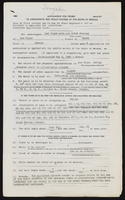Search the Special Collections and Archives Portal
Search Results

Letter from Walter R. Bracken (Las Vegas) to W. H. Hulsizer (Omaha, Neb.), July 16, 1940
Date
Archival Collection
Description
Table showing gallons and percentage of water used by The Las Vegas Land & Water Co. in Las Vegas, and used and sold by the Union Pacific Railroad Co. in 1937, 1938, and 1939.
Text

Letter from A. M. Folger (Las Vegas) to Frank Strong, November 6, 1947
Date
Archival Collection
Description
Report of the discussion regarding the creation of the Las Vegas Valley Water District at a Rotary meeting.
Text

Newspaper clipping, Las Vegas Valley water withdrawal keeps even, Las Vegas Review-Journal, July, 21 1948
Date
Archival Collection
Description
Residents of the Las Vegas Valley were withdrawing water at the same rate as was being recharged.
Text

Newspaper clipping, County approves petition for Water District, Las Vegas Review-Journal, August 30, 1948
Date
Archival Collection
Description
Article describing how the Clark County Commission approved the petition to create a water district and set up plans for an election on the issue.
Text

Letter from Walter R. Bracken (Las Vegas) to Leo A. McNamee (Las Vegas), February 6, 1940
Date
Archival Collection
Description
Letter referring to water received by the Stewart family from the Union Pacific Railroad.
Transcribed Notes: Transcribed from handwritten text on letter: "May 1st, 1940 - Placed dam in ditch to divert all water to Burial Plot; May 27 - 2 1/2'' on weir, 8'' around weir. At Steward fence, water 3'' deep, 10'' wide."
Text

Letter from Walter R. Bracken (Las Vegas) to Leo A. McNamee (Las Vegas), April 1, 1942
Date
Archival Collection
Description
Bracken informing McNamee of the solution to the water delivery problem to the Stewart burial plot.
Text

Letter from Walter R. Bracken (Las Vegas) to R. L. Adamson (Los Angeles), March 11, 1935
Date
Archival Collection
Description
Bracken calling on the Assistant Chief Engineer to do something about the leaking
Text

Letter from Walter R. Bracken (Las Vegas) to F. H. Knickerbocker (Los Angeles), February 15, 1937
Date
Archival Collection
Description
Bracken informing Knickerbocker that if repairs are not done soon on their pipeline, it would fail catastrophically. If the water master was busy, he requested the authority to hire a local crew to do the repairs.
Text

Letter from A. M. Folger (Las Vegas) to William Reinhardt, September 11, 1950
Date
Archival Collection
Description
Officer followed up with owners of coolers not equipped with recirculation pumps and issued citations to those still not in compliance.
Text

